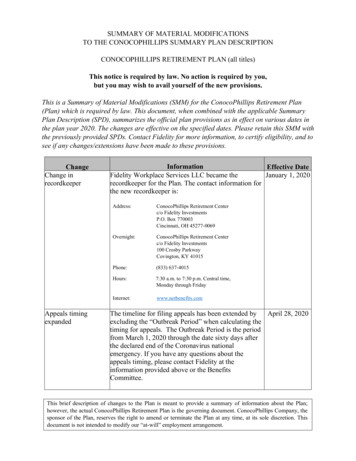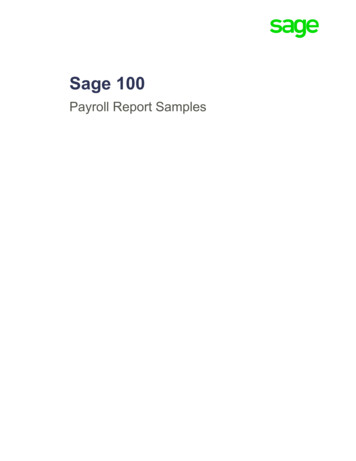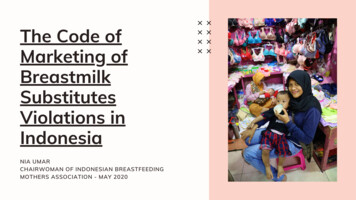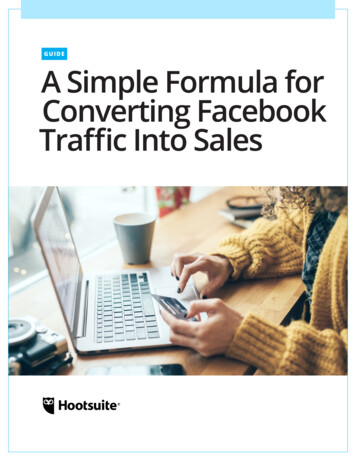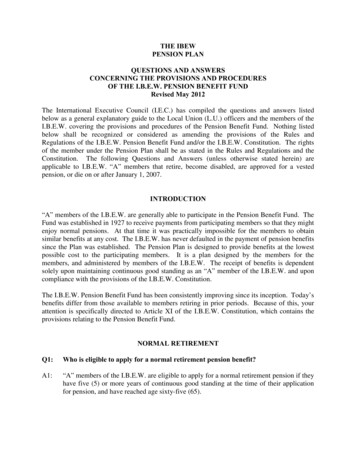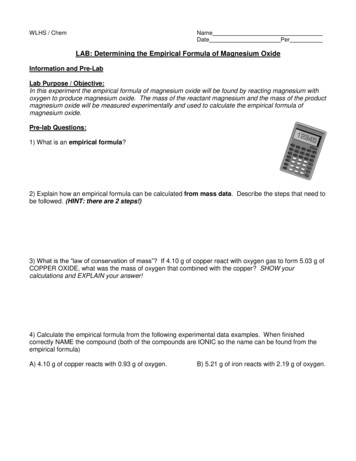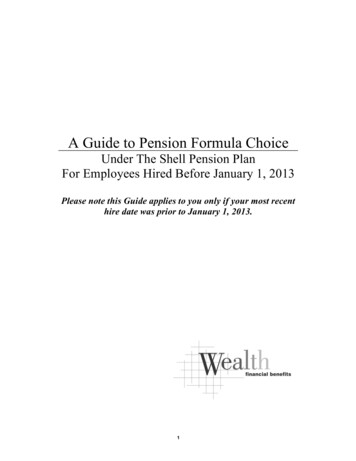
Transcription
A Guide to Pension Formula ChoiceUnder The Shell Pension PlanFor Employees Hired Before January 1, 2013Please note this Guide applies to you only if your most recenthire date was prior to January 1, 2013.1
ContentsPension Formula Choice . 3An outline of the tools available to make your pension formula choice and guidanceon how to use them.Your Future . 5A brief look at how and why Shell is giving you more pension flexibility than you can getat most major U.S. companies.Basics . 7Six important points to remember during the pension formula choice process.Highlights . 8A review of the highlights of the two pension formulas.Differences . 10These four key differences between the pension formulas will have the greatest influenceon your decision.Considerations . 12The three main areas you need to consider when making your choice are highlighted.Future Prospects . 13Your ideas about your own career goals and your assessment of the future of your businesswill have a significant influence on your pension formula choice.Financial Goals . 14When you hope to retire and how you want to spend your retirement will depend heavilyon your financial situation, and your pension formula choice may be influenced by those goals.Comparisons . 15How do the benefits from the two pension formulas compare?Scenarios . 16Review possible reasons why Shell employees in two pension-point ranges(80 points and above, and below 80 points) might choose a particular pension formula.For Yourself . 18You can use this worksheet to help you make your pension formula choice.Legacy Company Service . 19Pension Formula Choice Questions & Answers . 21More details about how the two pension formulas work.This guide is intended to summarize only the highlights of the Shell Pension Plan. If there is any conflict between thissummary and the actual plan document, the plan document will control. For additional information on the PensionFormulas, refer to the Dimensions Wealth Summary Plan Description which can be located on HR Online (under MyBenefits) or via NetBenefits .2
Pension Formula ChoiceYour Shell* pension will be a valuable part of your financialfuture. Since you are theone shaping that future, you are in the best position to make the decision about which of Shell’stwo pension formulas will fit your needs. The material included in this guide is designed to helpyou organize your thinking and makeyour choice. The Shell pension benefit is fundedentirely by the companies that participate in the Shell Pension Plan. There is no cost to you forthis benefit.**Pension Formula Choice EligibilityIf you were hired before January 1, 2013, you have access to the Accumulated Percentage and the80-Point Pension Formula. You made your initial election within 31 days of becoming an employee of aparticipating company, otherwise you were defaulted into the Accumulated Percentage Formula. Yourfuture pension benefits are calculated under the same formula until you elect a different pension formulain subsequent years.If you were hired or rehired on or after January 1, 2013, you are not eligible for pension formula choice;you are automatically enrolled in the Accumulated Percentage Formula and cannot elect the 80-PointPension Formula.Pension Formula Choice Annual EnrollmentThere Information about the timing and the mechanics for making your pension formula choice will beprovided in the fall of each year. If you want to keep your current formula for future benefits, you do not have to make anelection. If you want to switch to a different formula for future benefits, follow the enrollmentinstructions you will receive to make that choice.If you terminate employment with all participating companies after December 31, 2012, and are rehired,you are treated as a new employee and will be enrolled automatically in the Accumulated PercentageFormula.* Throughout this brochure, Shell includes Shell Oil Company and its affiliated and subsidiary companies that participate in the Shell PensionPlan. In certain cases, Shell may also include affiliates that do not participate in the Plan.** A pension is a form of deferred income. The usual pension paid from the Shell Pension Plan is a monthly annuity payable for life and, in somecases, a monthly annuity payable to a survivor. Some pension benefits may be payable as a single lump sum.3
If You Came into the Shell Pension Plan from Another Companyin an Acquisition or MergerEmployees of companies that have become participating companies in the Shell Pension Plan, includingPennzoil–Quaker State Company, alliance companies (including former Texaco and Star Enterpriseemployees and former employees of Texas New Mexico Pipeline), and CRII may be eligible for a ShellPension Plan benefit.Service with these companies may have an impact on your pension benefits with Shell and is referred toas “Legacy Company Service.” You can find more information about how your legacy service countstowards 80-Point eligibility or APF points in the Legacy Company Service section of this guide.Pension Formula Choice GuideIf you are eligible for Pension Formula Choice, this guide will help you consider the Shell Pension Plan’stwo pension formulas and prepare you to make the choice that best fits your situation. You can get themost benefit from this guide by following these steps: Start with the Basic Information: Everyone who makes a pension formula choice shouldreview these sections of this guide (Your Future, Basics, Highlights, Differences,Considerations and Questions & Answers). Read More if You Need It: Learning the basics may give you enough information to makeyour choice. If not, review the pages covering pension formula choice considerations: FutureProspects, Financial Goals, and Comparisons. You can also access the Pension ModelingSoftware on your computer if modeling examples of the two formulas will help you (see“Shell Pension Choice Modeler” below). Gather Additional Information: Collect data until you have enough information to make thechoice that best fits your situation. You can change pension formulas each year for futurebenefits if your situation changes. Make Your Choice and Enroll: Use the “For Yourself” worksheet provided in this guide tomake sure you are comfortable with your choice. You should save this guide and refer to itwhen you want to review your pension choice. Shell Pension Choice Modeler: You will see a reference in the guide when your decisionmaking process can be enhanced by using the Shell Pension Choice Modeler, which can befound on HR Online (under My Benefits, United States Wealth, Shell Pension Plan, Pensionchoice), or at www.benefitmodeling.com/shellchoice.4
Your FutureNot many people fully understand or appreciate the value of a pension until they are on the vergeof retiring or leaving a company. At most other companies, there is little they can do to affectthe benefit, so there is little incentive for young or even middle-aged employees to think muchabout their pensions. Shell has changed your role by offering a choice of pensionformulas within the Shell Pension Plan.You can choose between two pension formulas to provide your future benefits: 80-Point Pension Formula: The “traditional” 80-Point Pension Formula bases your benefitson your age, average final compensation, your primary social security benefit and accreditedservice under this formula. You generally must attain a minimum age and years of servicebefore you can receive payment under this formula. Accumulated Percentage Formula: With the Accumulated Percentage Formula youaccumulate a percentage each year that is used to calculate your benefit amount. Yourannual percentage is based on a schedule using the number of points (your age plus yourAccumulated Percentage Formula Service) that you have at the end of the prior calendar year.When you terminate, your annual percentages are added together and the total is multiplied byyour Average Final Compensation to calculate a single lump-sum amount or a monthlyannuity. There is more flexibility as to when the pension can be paid, and the benefits underthis formula can be combined more easily with benefits from other employers.Both formulas offer a solid foundation for retirement when considered along with your Shell ProvidentFund (SPF), Social Security, personal savings, and benefits you and/or your spouse may have from otheremployers. However, one of the formulas, or a combination of the two, is likely to be a better fit for you.Because your situation may change during your time at Shell, you are free to change your pension choiceon an annual basis.5
Benefit Restoration PlanIf you are eligible for benefits under the Benefit Restoration Plan (BRP), your pension formula forpayments from the BRP will match the pension formula you select for the Shell Pension Plan. However,you may elect an immediate lump sum BRP payment under the 80-Point Pension Formula if you leavewith 80 points and you make your election prior to termination from Shell. You will be notified ifrestoration benefits apply to you.Your Assessment of the Future Is CriticalBefore choosing or changing your pension formula, you should make assessments about the futureand consider your financial goals. What you learn in this process will cast your pension in a new light,helping you see it as a financial benefit that provides value each year and at every age rather than as avague vision of a pot of gold at the end of a distant retirement rainbow.Shell is committed to giving you more control over your pension. The company also plans to help youtake advantage of this new freedom in ways that will build your knowledge and appreciation of whatyour financial future may hold as a result of your retirement benefits.All statements about the value of your pension benefits are based on assumptions involving lifeexpectancies as projected based on past experience. Any pension benefit may be paid for a longer orshorter period than may be anticipated. The “value” of benefits under either pension formula may belesser or greater, depending on your actual experience.6
BasicsBefore you learn the specifics of the Shell Pension Plan’s two pension formulas, it isimportant for you to consider six key points about the pension choice process:1. Both Pension Formulas Deliver Valuable Benefits: No matter which formula or combination offormulas you choose, over time you can expect your pension to form a solid foundation for yourretirement. The 80-Point Pension Formula usually delivers a greater comparative benefit to employeeswho are at least 50 and whose age and eligibility service add up to at least 80 points, but it also pays abenefit to those who leave without 80 points. The Accumulated Percentage Formula usually delivers agreater comparative benefit to those who leave Shell before reaching the 80-point level, but it alsopays a substantial benefit to those who reach 80 points. Some employees may wish to spend a numberof years in each formula, and the combination of the formulas will ALSO result in a solid retirementfoundation. You must have a minimum of three (3) years of vested service to receive a benefit fromthe Shell Pension Plan, regardless of the formula you elect.2. There Is No “Right” Pension Formula Choice: You already make investment choices for your ShellProvident Fund (SPF) money by assessing the potential risks and rewards and are appropriate for yourindividual situation. Your pension formula choice is similar, although other matters may also need tobe considered. You will pick a pension formula you are comfortable with based on your assessment ofyour needs and what you believe lies ahead for you and for the company.3. Your Choice Is Confidential: The pension formula you choose shouldn’t be seen as an indicator ofyour commitment to Shell. To eliminate that concern, your pension choice will be confidential.4. You Can Change Your Pension Formula Choice Every Year: The factors affecting your pensionformula choice are subject to change, so Shell allows you an option to change formulas every year asneeded. Of course, future changes will only affect future benefits. If you elect to make a change, thiselection will affect the way in which your pension amount is calculated for the next calendar year. Thiselection will not affect your pension amount earned in past years. Your final pension will be a sumtotal of what was earned from the two formulas. This is referred to as a “hybrid” approach.5. Your Choice to Change Formulas Affects ONLY Future Pension Benefits: Any pension benefitsyou have earned based on Shell service before you make your change are not affected. A change onlyaffects benefits you earn after your change goes into effect.6. Your Pension Is Just One Part of Your Retirement Income: At retirement, you will have incomeavailable from your pension and a number of other possible sources. You may also have benefits fromother employers if you don’t spend your full working life at Shell. Consider your retirement incomesources and remember that your pension choice does not affect any other retirement income sources.7
HighlightsImportant features of your pension are highlighted here. More details can be foundin the questions and answers at the end of this guide and in the Dimensions WealthSummary Plan Description.Benefit Formula80-Point Pension FormulaAccumulated Percentage FormulaThis formula calculates a monthly pensionamount which is payable to you beginning atage 65. Your monthly amount grows based onincreases in your 80-Point Pension FormulaService and your AFC. Generally, here is howthis formula determines your benefit:You accumulate a “percentage” each year thatis used to calculate your benefit amount. Yourannual percentage is based on a schedule usingthe number of points (your age plus yourAccumulated Percentage Formula service) thatyou have at the end of the immediatelypreceding calendar year. When you terminate,your annual percentages are added together andthe total is multiplied by your AFC to calculate asingle lump-sum amount. Service under the80-Point Pension Formula isn’t used incalculating your points for this formula.This schedule is:1.6% X Your Average Final CompensationTimesAccredited Service Under This FormulaMinusSocial Security Offset(delayed until you reach your Social SecurityNormal Retirement Age)A regular pension is calculated to begin at age65, but there are circumstances under whichpension payments can begin as early as age 50if your age and all Shell plus eligible legacycompany service equal 80 when added together.APF PointsPercent of AverageFinal �7980 3.0%4.0%6.0%8.0%10.0%13.0%16.0%You can take this amount as a lump sum or asa monthly payment when you leave Shell butnot later than when you reach age 65.8
How You Receive Your Benefits80-Point Pension FormulaAccumulated Percentage FormulaIf Married: You get a monthly payment overyour lifetime, and, after your death, yoursurviving spouse generally will receivemonthly lifetime payments that are generallyhalf the amount of your monthly lifetimepayments. This spouse’s benefit is “free” toyou if you retire after attaining 80 points,meaning that your payments will not bereduced to pay for your spouse’s 50%payments.If Married: You decide if you want either thelump sum (based on the formula) or if youwant to receive monthly payments for life.However, your spouse must consent to a lumpsum.If you elect monthly payments, you can alsoarrange for monthly lifetime payments to asurviving spouse. However, your monthlybenefit will be reduced for the cost of thisadded benefit as this formula does not offer“free” 50% surviving spouse payments.You can choose to leave payments greater than50% of your benefit to a surviving spouseand/or you may choose an additional person toreceive benefits after your death, but yourbenefit will be reduced to pay for these options.If you delay your decision and leave youraccount on deposit with the plan, it will growat the 30-year Treasury security rate until youare ready to decide.If Single: You can give a “free” 50% survivorpayment to a beneficiary who is the same age,older, or not more than five years younger thanyou. If the beneficiary you choose is more thanfive years younger than you, your lifetimepayment will be reduced to pay for theadditional age difference. You may increasethe amount payable to your beneficiary and/oryou may add an additional person to receivebenefits after your death, but your benefit will bereduced to pay for these options.If Single: You have the same choices as amarried employee: You can name a beneficiaryto receive a 50% lifetime payment after yourdeath, AND, your lifetime payment will bereduced to pay for any survivor benefit.9
DifferencesFocus on these four major differences between the formulas when considering whichpension best fits your situation.Your Benefits Accumulate Differently80-Point Pension FormulaAccumulated Percentage Formula“Back-loaded” benefits:The benefit you are entitled to grows slowlyuntil your age and your accredited service addup to 80. At that point, the benefit you areeligible for increases dramatically. This issometimes called a “cliff” benefit.“Front-loaded” benefits:Your benefits accumulate year-by-year,growing at a gradually increasing rate overthe course of your accredited Shell service.There is no dramatic increase upon reachingthe 80-point cliff.What This Means to You:If you have reached or reasonably expect toreach the 80-point “cliff” before you leave thecompany, you can expect to receive a largerpension benefit from this formula.What This Means to You:If you leave the company for any reason beforereaching the 80-point “cliff,” you can generallyexpect to receive a larger pension benefit fromthis formula.You Can Receive Your Benefits Differently at Retirement80-Point Pension FormulaAccumulated Percentage FormulaMonthly lifetime payments.Monthly lifetime payments or one lumpsum payment.What This Means to You:The value of any benefit you earn under thisformula will be calculated as an amount paidto you in equal monthly amounts afterretirement. You cannot elect a lump sumpayment from this formula. However, thereare certain exceptions for payments madefrom the Benefit Restoration Plan. Generally,unless you are eligible for an immediatepension when you leave Shell, you maynot begin pension payments until you reachage 65, unless your age and Shell plus eligiblelegacy company service equal 80 pointsbefore age 65.What This Means to You:You will be eligible to receive all of the benefityou earn under this formula either as a lumpsum payment (with your spouse’s consent) oras monthly lifetime payments to you after youleave the company and elect to receive thepayments. You can receive benefits wheneveryou terminate employment or defer payment upto age 65.10
Inflation May Affect Your Pension Benefits Differently80-Point Pension FormulaAccumulated Percentage FormulaWhile Shell is not required to adjust pensionpayments for inflation, the company hasapproved inflation adjustments from time-totime for retirees who have retired witheligibility for an immediate pension under the80-Point Pension Formula (and their survivingbeneficiaries who are getting payments).A monthly payment may be eligible for inflationadjustments; a lump sum is not eligible.What This Means to You:If you take benefits under this formula asmonthly payments and you satisfy thetraditional 80-point eligibility rules, you willbe eligible for any future inflation adjustments.Lump sums are not eligible. Remember—thecompany has no obligation to make inflationadjustments and there is no guarantee that theseadjustments will be made in the future.What This Means to You:From time to time, Shell has adjusted pensionannuity payments to partially offset the impactof inflation on retirees. Remember—thecompany has no obligation to make inflationadjustments and there is no guarantee that theseadjustments will be made in the future.You Make Different Adjustments to Provide Spouse Benefits80-Point Pension FormulaAccumulated Percentage FormulaA surviving spouse gets a “free” 50% lifetimepayment if you retire with immediateeligibility for a pension. The beneficiary of asingle employee also gets a “free” 50%lifetime payment if you retire with immediatepension eligibility and the beneficiary is notmore than five years younger than you.A surviving spouse gets a 50% lifetimepayment that you pay for by reducing yourmonthly payments.What This Means to You:If you are married or single and take monthlypayments under this formula, they will besubject to standard rules used by pensionactuaries to make reductions to your paymentsto cover the cost of 50% monthly lifetimepayments to your surviving spouse orbeneficiary. If you are married you can choosenot to buy this benefit for your spouse if yourspouse agrees in writing to waive the benefit.What This Means to You:If you are married or single and take a benefitunder this formula, there is a special featurethat lets you provide a 50% monthly lifetimepayment to your surviving spouse or certainbeneficiaries without reducing your monthlypension payment.11
ConsiderationsMaking your pension choice is not a straightforward task of calculating which formula deliversthe biggest benefit. There are too many variables for such a simple equation to work. Tomake the best choice for yourself, you need to makeassessments in three related areas and use thatinformation to choose.The Numbers Don’t Tell the Whole StoryYou may be tempted to go straight to the formulacomparisons to find out which one delivers the biggestretirement benefit. While this is very important, you can easily be misled if you only look at thenumbers. The 80-Point Pension Formula will usually deliver greater benefits in a side-by-sidecomparison if you project obtaining 80 points at Shell. However, the Accumulated PercentageFormula may provide higher earlier payments for a shorter Shell service period projection. Further,the Accumulated Percentage Formula is payable as a lump sum or an annuity, while the 80-PointPension Formula is only payable as an annuity. Be sure to consider your future prospects and yourfinancial goals to determine a realistic expectation and a worthwhile goal for you. Your Future Prospects: The biggest difference between the two Shell pension formulasis the way they accumulate benefits over time. If your age and eligibility service adds up to80 points the traditional 80-Point Pension Formula will generally pay a larger benefit. Ifyou leave before reaching 80 points, the Accumulated Percentage Formula will oftenprovide a greater benefit. You must make basic assessments about where you are, whereyou think the company is going in the future and where you hope to be at retirement. Yourjudgment about whether obtaining 80 points is likely or desirable for you will have a bigimpact on your choice. Your Financial Goals: Consider how your financial vision for your future might affectyour pension choice. Does it matter to you whether you receive a monthly payment foryour lifetime or a lump sum? When do you plan to retire? How do you plan to protect yourretirement income from inflation? Have you considered your other assets such as the SPF,personal savings, and social security benefits? Your pension is a cornerstone for yourretirement income, so you will want to make a choice that will give you the firmestfinancial foundation to build on. Pension Formula Comparison: Your assessment of your future prospects and financialgoals may point to a clear choice for you. Even if your choice is obvious, take a look at thebenefits paid by the two pension formulas. While you may not be confident about yourchance of reaching 80 points or reaching age 65 before leaving, you could decide that thebenefit difference is great enough to make the risk worthwhile. You may decide that theAccumulated Percentage Formula will meet your needs no matter how long you work forShell. Or you may decide that switching between formulas over the years will work bestfor you.12
Future ProspectsDo you expect to remain employed with a Shell company until you retire?Some reasons for offering the Accumulated Percentage Formula are to accommodate the growingnumber of mid-career hires, to help mid-career employees leave Shell if that fits their plans, andto provide a better benefit for people who don’t want to work with just one company during theirlifetime or who don’t think it’s likely that one business will continue in its present form longenough to offer them long-term employment.You can’t predict the future, but you can ask yourself questions that may guide you to a pensionformula choice with which you can be comfortable in the future.What Do YOU Want? Some people still start with a company with the goal of staying for life,but there are many other employment paths. Consider whether you expect to stay at Shell longenough to get 80 points.Where Can You Get More Information?Here are examples of information sources that may help you make your assessment: Shell in the United States - Annual Review: Includes data about recent business trends,successes, challenges and financial highlights. Shell Communication: Company publications and the intranet provide a constant data flowabout the current state and future prospects of Shell’s businesses. Industry Publications: Magazines cover mergers, acquisitions, sales and other business trends.Many also have on-line versions.13
Financial GoalsWhen you picture retirement, are you relaxing in a porch rocker? Golfing your way acrossthe country? Starting your own small business? Since your Shell pension will contribute some ofthe money you’ll need to make your picture a reality, you should make your choice with thosegoals in mind.You may not be close enough to retirement to have a specific vision of your goals. Even youngpeople have some thoughts about the future. Ask yourself these questions to see if you uncoverany information that will influence your pension choice.Do You Want to Retire Early? Your likelihood of reaching 80 points depends on your age andservice at retirement, so your retirement plans could affect your choice. If you won’t have 80points before you retire, the Accumulated Percentage Formula may be your best option. Considerhow any goal of early retirement may affect your choice.Will You Need a Lump Sum When You Leave the Company? Maybe you hope to start abusiness after you retire that will require a large amount of cash. The Accumulated PercentageFormula offers a lump sum payout option that could influence your decision. Assess whether thefact that a lump sum payout under the Accumulated Percentage Formula has any impact onyour choice.Are You Planning on a High-Maintenance Retirement Lifestyle? Shell’s combined pensionand savings benefits will help prepare you for retirement. However, your idea of retirement maycost more than the average person’s. Consider whether you are likely to have unusual financialneeds in retirement and factor those into your pension decision.Where Can You Get More Information?Here are examples of information sources that may help you make your assessment: Other Benefits: You will have retirement income from a number of Shell benefits as well as fromother employer’s plans, Social Security and personal savings. Review your total retirementpotential to decide how your pension fits. Financial Experts: If you have someone who helps you with your taxes or estate planning, youmay want to discuss your pension choice with that person. Retirees: Retired friends or relatives will be able to speak from experience about the challenges ofdeveloping a financial plan to support their retirement. Their insights may be valuable. Friends & Colleagues: You may know or work with others who have similar circumstances.Discussing goals with them may help you clarify your own ideas.14
ComparisonsHow different are the pension formula benefit levels? How much can you expect from the80-Point Pension Formula if you leave before reaching 80 points? How much can you expectto miss out on if you choose the Accumulated Percentage Formula and then you do reach 80points?How much do you lose or gain by switching back and forth? There are too many unknownvariables to determine exactly how much money the two formulas will deliver to you, butexamples can be a guide.The Shell Pension Choice Modeler lets you
Use the “For Yourself” worksheetMake Your Choice and Enroll: provided in this guide to make sure you are comfortable with your choice. You should save this guide and refer to it when you want to review your pension choice. You will see a reference in the guide
